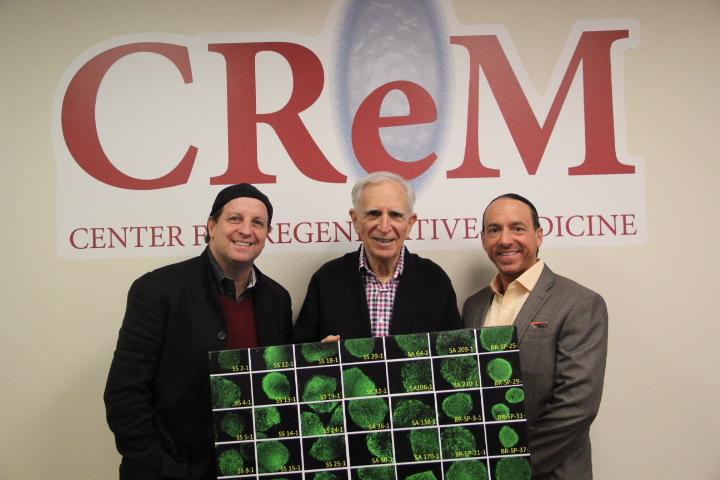
Boston Medical Center & Boston University School of Medicine Center for Regenerative Medicine researchers: (L-R): Gustavo Mostoslavsky, M.D., Ph.D., Martin Steinberg, M.D., George Murphy, Ph.D. Source: Boston Medical Center
Scientists at the Center for Regenerative Medicine (CReM) at Boston Medical Center (BMC) and Boston University School of Medicine (BUSM) are creating an induced pluripotent stem cell (iPSC)-based research library that opens the door to invaluable sickle cell disease research and novel therapy development.
The library comprises blood samples from ethnically diverse patients with sickle cell disease from around the world and represents the major genetic backgrounds on which the sickle cell mutation occurred. The library is outlined in the current online issue of the journal Stem Cell Reports.
iPSCs are cells that can renew indefinitely as undifferentiated cells and later can be directed to grow into any type of tissue or organ. These stem cell lines can then be used to create disease models in a lab, which allows researchers to better understand how the disease occurs and develop and test new, effective treatments against the disease.
“Sickle cell disease affects millions of people worldwide and is an emerging global health burden,” said George Murphy, PhD, co-founder of the CReM and assistant professor of medicine in the division of hematology-oncology at BUSM who is leading the project. “iPSCs have the potential to revolutionize the way we study human development, model life-threatening diseases, and eventually treat patients.”
Sickle cell disease (SCD) is an inherited red blood cell disorder that causes abnormal hemoglobin in blood. Hemoglobin is a red blood cell protein that carries oxygen throughout the body. Red blood cells that contain normal hemoglobin are disc shaped and can easily move through the blood vessels. Sickle-shaped cells are not flexible and can stick to vessel walls, causing a blockade that can slow or stop blood from flowing properly. The lack of tissue oxygen can cause severe, chronic pain and organ damage.
“In addition to the library, we’ve designed and are using gene editing tools to correct the sickle hemoglobin mutation using the stem cell lines,” said Gustavo Mostoslavsky, MD, PhD, co-founder of the CReM and associate professor of medicine and microbiology at BUSM who is co-leading the project with Murphy. “When coupled with corrected sickle cell disease specific iPSCs, these tools could one day provide a functional cure for the disorder.”
SCD is a lifelong illness. According to the World Health Organization (WHO), approximately 5 percent of the world’s population carries trait genes for SCD, which disproportionately affects African Americans and Hispanics. In the United States, approximately 100,000 people are affected by SCD. The Center of Excellence in Sickle Cell Disease at BMC is the largest center in all of New England to provide care for SCD patients across their lifespan–treating approximately 450 adults and pediatric patients annually.
“CReM researchers investigate diseases that are more prevalent in BMC patients, including sickle cell disease, to make strides in treating diseases that disproportionally affect vulnerable populations,” said Martin Steinberg, MD, professor of medicine at BUSM and co-author of the paper. “With their philosophy and guiding principles, the results that they share could help speed up the process of finding novel treatments and potentially cures for diseases affecting people across the world.”
The library is part of a larger NextGen Consortium study funded by the National Institutes of Health (U01HL107443). In keeping with the CReM’s philosophy of ‘open source biology’ and the sharing of cells, reagents and know-how with the research community, these stem cell lines are available to researchers worldwide.




